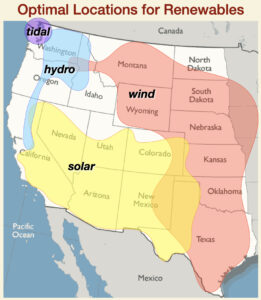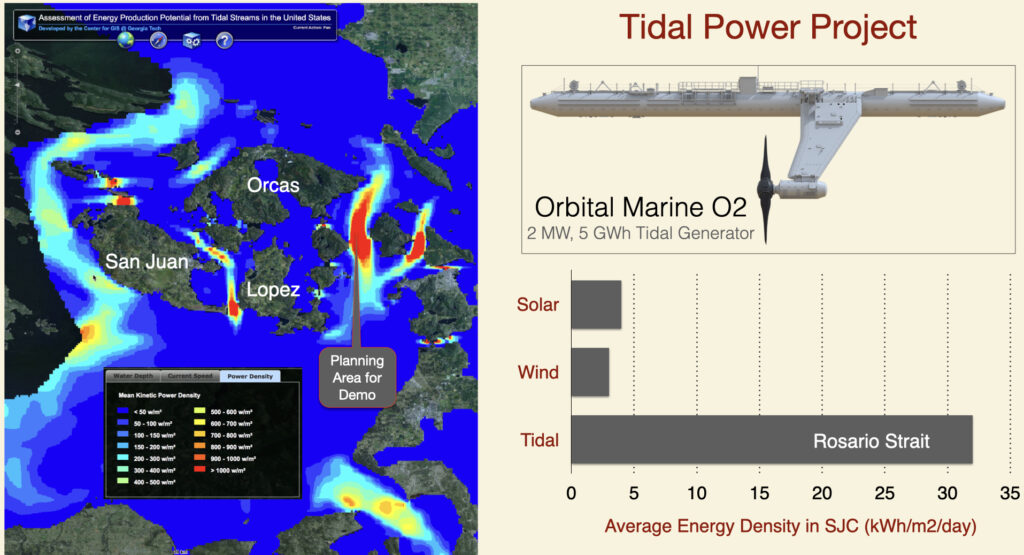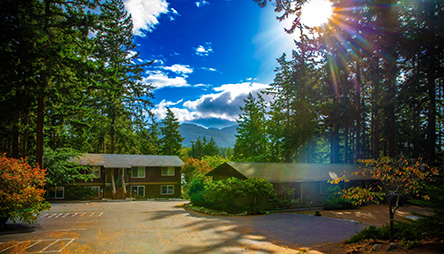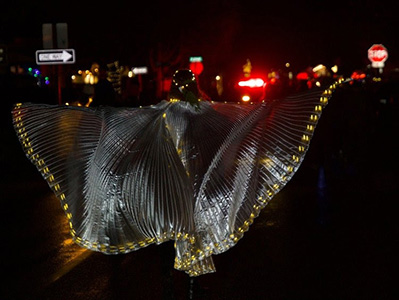||| EARTHRISE BY JAY KIMBALL |||
As we look to other island communities for examples of climate action and innovation, the Orkney Islands will undoubtedly be on the short list. Its pioneering work harnessing tidal energy is inspiring the world. This is especially so in higher latitudes, like the Salish Sea, where tidal flows are very strong.
Location, Location, Location
 When a famous hotelier was asked what three factors were key to the success of his hotel chain, he answered: “Location, location, and location!“
When a famous hotelier was asked what three factors were key to the success of his hotel chain, he answered: “Location, location, and location!“
The same can be said of renewable energy. Each type of renewable energy has locations where it stands out. In the southwest, solar is abundant year-round. Wind blows strong east of the Cascades. Hydro is abundant in the northwest. And in the Salish Sea, tidal energy is the renewable force of nature.
The continuous, regular ebb and flood of the sea – about every 6 hours – means less energy storage is needed to smooth and firm the powerful pulses of tidal energy. Wind energy can lull for weeks, and solar for months in winter. Tidal’s steady predictable rythm makes it an important candidate for increasing local energy resilience and reducing our dependence on the mainland, especially in winter.
“The tide is more dependable than most other renewable energy sources. Wind is great, but fickle. The sun is even better, but cloud cover can interfere with production. Also, the sun’s energy is available only during daylight hours, and mostly during the summer. Our greatest need for energy is exactly opposite this schedule: we need the most energy at night and during the winter.” ~ Jonathan White, Orcas Islander, author of Tides: The Science and Spirit of the Ocean
Tidal Energy Workshop
If you want to learn more about this promising local renewable energy, OPALCO is hosting a workshop on tidal energy this Wednesday. The OPALCO team is in the preliminary stages of evaluating the promise of tidal energy around the San Juan Islands. With Washington Department of Commerce funding, staff and contractors have been working on conceptual design and siting studies.
The workshop is from 5 to 6 pm this Wednesday, 22 March. To learn about the technology, potential demonstration site, and current status on this project, register for the workshop at: OPALCO Tidal Energy Workshop
The left side of the chart below shows where tidal flows are strongest (red). The bottom right shows how tidal energy is about 8 times stronger than wind or solar per square-meter of generator surface. And the upper right shows the Orbital Marine O2 tidal generator deployed in the Orkney Islands. It has been in operation for over a year, has a peak output of 2 MW, generating about 5 GWh per year.

Earthrise: A Climate Action Journal
This climate action journal offers information and actions we can take together, locally and globally, as we care for this precious Earth.
“The best way to heal a living system, is to connect it with more parts of itself.” ~ Margaret Wheatley
If you like what you read here, pass it forward to a few friends and ask them to do the same. Like a pebble tossed in a pond, the rings emanate outward, reflecting and growing exponentially. “Going exponential” is what it will take to reverse the climate extremes that are accelerating around us.
Thank you…
+ Get an alert when there’s a new Earthrise post: Notify Me!
+ Previous Earthrise posts:
• First Light • Robert Dash – photographer, educator, environmentalist • Extreme Rain • A Poem for the Snow Leopard •
• How the Chinese spy balloon can inspire climate action •
Notes
The world’s most powerful tidal turbine has begun to generate electricity from the sea in Orkney
Jonathan White, Orcas Islander, author of Tides: The Science and Spirit of the Ocean
**If you are reading theOrcasonian for free, thank your fellow islanders. If you would like to support theOrcasonian CLICK HERE to set your modestly-priced, voluntary subscription. Otherwise, no worries; we’re happy to share with you.**









I have been promoting tidal energy production to anyone that will listen at OPALCO for 30 years. The Snohomish PUD project in particular should have been followed up on. https://www.snopud.com/community-environment/our-energy-future/projects/research/tidal-energy/tidal-project-overview/
I guess it goes to show that good ideas alone are not enough; the timing has to be right socially and economically. Maybe the time is finally right?
Personally, I would rather see MANY small rafts anchored in tidal flow waters with small, easily maintained and repaired generators hanging alongside bags of mussels and oysters. Dispersed generation requires far less mega infrastructure and is FAR more resilient in the long run. ONE failure of a critical underwater power cable can (and has) disrupt not just power but fiberoptic/telephone/EMS systems. Better to have many small, fixable, affordable systems even in less than ideal locations than just one big, vulnerable generator out in the most exposed waters of the region.
Thanks again, Jay. This is a timely post as I’m reading Jonathon White’s book because I’m fascinated by all things tidal.
I like Ken’s comment, too.
Does this system need energy storage, Jay, or can the power just be pumped directly into the grid, which then compensates for the variability?
I’m guessing the former, and that batteries could do the job.
Michael, One of the benefits of local generation is to operate during mainland outages, especially powering critical services like first responders, medical facilities, shelters, grocery stores, etc. To optimize that, OPALCO pairs storage with its local generation – e.g. community solar, tidal, etc.. That way, when there is no mainland power to “backfill” the local production, storage helps ride through dips in local production – e.g. solar at night, winter, or during cloud strikes, and tidal during slack tides. Tidal requires less storage per MW since the tidal energy pulses average about every 6 hours.
The one other important engineering activity that is ongoing is what is referred to as “grid modernization,” which includes more granular switching to “route” energy to critical services when there isn’t enough energy to power everyone.
Grid modernization and local energy + storage systems are major areas of grant activity for OPALCO, particularly from WA Dept. of Commerce Clean Energy Fund, and US Dept. of Energy.
OPALCO’s first Clean Energy Fund grant they won was for a storage system design that had seven use-cases, for things like firming, peak shaving, extending the life of submarine cables, outages, etc.
Michael, good question. Opalco must meet load as it rises and falls, instantaneously. Now, this load following is done for opalco by bpa.
Tidal is a good energy source, if economic. It is not a good capacity source.
It varies with the tidal currents. These are predictable but can vary greatly, tide to tide and seasonally. The tidal output will require additional capacity (battery or more likely other generation) to meet the opalco load swings.
This will be an important challenge as the bpa contract is renegotiated or terminated.
Worrying about load swings for a pilot project that, as designed, will produce less than 1/2 of 1% of OPALCO’s annual usage seems premature. Using EV batteries hooked into the grid when not being driven is one potential solution.
Those of us who are no older than middle aged will see EV batteries made part of local grid storage. If only 10% of Seattle-registered vehicles were both EV and connected to the grid, assuming an average 60 or so kWh battery in each, about one gigawatt hour could be stored and drawn. That’s an extreme case, but vehicle batteries just sitting there are a wasted resource. The Department of Energy and EV manufacturers are working the problem, the race being who comes up with a standard interface all can agree on. But when it comes to pass, as I think it will, our local grid will be able to “breathe” fresh power when it needs it.
While the tidal energy generator is a fascinating piece of technology, the OPALCO website estimates the cost as an eye-popping $50 million!
https://www.opalco.com/quick-fact-opalco-tidal-energy-pilot-project/2022/11/
It would take a large fleet of these to make a dent in our consumption from BPA and if the goal is to cover the gap during mainland outages, land-based energy storage would be cheaper, easier to service, faster to install, and would have virtually no environmental impact beyond a concrete pad about the size of a shipping container.
A utility-scale battery backup system like the Tesla Megapack can be installed in about a month, as it ships fully assembled. It can discharge 3 MWh per hour. OPALCO uses about 215 MWh per year or about 0.6 MWh per day on average. A 3 MWh Megapack could power the San Juans for five days! And the system could not only be used for emergency backup storage, it could potentially be used for load shifting to reduce demand from BPA during times of peak loads, theoretically resulting in lower energy costs that eventually pay for the cost of the system over a number of years.
Additionally a land-based battery storage system would cost far less than a tidal generator – the base model of the Megapack is $1.5 million with 3 MWh of discharge capacity. That’s over 33x less than the cost of a $50 million tidal generator.
The San Juans are far less remote than the Orkneys and we already have an existing interconnection with a mainland grid, plus local infrastructure with a capacity for 1 GWh (per the 2020–2040 Long Range Plan from OPALCO). We don’t need to run pilot projects with numerous unknowns when the technology to completely eliminate outages already exists in a more affordable and readily deployable package.
If my info is wrong I’d welcome corrections from the informed folk commenting here, but a tidal turbine seems like a solution in search of a problem.
A lot of discussion assumes that OPALCO is taking measures to assure business as usual. That, of course, is the desired condition, but the way the Western Grid is shaping up, that is increasingly unlikely. The transition from fossil fuels to renewables, while necessary, has been more abrupt than grid reliability and available capacity may allow. No matter how generated and stored, power will become more expensive.
Given the very real possibility of this scenario, and the relatively long planning period for even local power projects, some experimentation is in order. Experimentation also has one valuable feature: it invites grants, relieving our lopsided seasonal economy and its members of an onerous burden. With the assurance of locally generated power, service can be triaged to where it is needed most. While I have no inside information about this, it would be logical to expect that OPALCO is looking at how to operate our local grid to facilitate this. This would likely be the case even if a Megabattery charged by BPA were involved, and some storage of tidal power should be expected.
From the outside where I stand, it looks to me that OPALCO is looking at two events: Interruption from the mainland, and peak market power prices lasting more than, say, five days. It’s not as hard to plan for one or the other, but OPALCO’s obligation to provide power to the extent possible requires them to plan for both events at once. I am fully in support of this effort.
I think it’s a fair question to have OPALCO provide an estimate of expected (or hoped for) grants and OPALCO ratepayers cost for the initial tidal generator and storage (if a battery storage is planned). Tidal generation is exciting technology, but 2 MWH is a pretty minor power gain when the current peak load requirement is about 80 MWH, and that is expected to double by 2050.
If the estimated $50 million can all be grant funded, great. If not, the OPALCO Board needs to be transparent on what might be expected from OPALCO ratepayers.
There are tidal generation projects in the world that produce greater MWHs than San Juan County is expected to need by 2050. But, that usually means putting tidal generators on a bay that essentially has significant tides and the bay essentially has a dam like structure for the installation of multiple turbines. That type construction isn’t likely to ever happen in the Salish sea.
According to the OPALCO description at Mr. Bowman’s link, the Orbital tidal power unit could generate up to about 2 MW peak power and 4.6 to 5.6 GWh/year, so his figure of 215 MWh/year total OPALCO electricity consumption must be incorrect. Maybe he meant to say 215 GWh/year, which sounds more reasonable.
Using OPALCO’s estimated cost of $50M, that’s $25 per peak watt, roughly 20 times what it costs for a residential solar energy system these days. Or if you instead use average power of 0.57 MW (equals 5 GWh/(24h x 365)), the costs come in at about $88 per average watt. But we have to remember that these are the early days of tidal power, so this is an experimental project worth investing in, if the funds come from state and federal sources. Photovoltaic costs have come down a factor of 20-25 since far-sighted venturers (and hippie communes!) began using solar cells for remote installations in the 1970s.
As Jay’s article and chart show, the tidal power densities around the San Juan Islands vastly outweigh those of solar and wind power. Who else is better positioned to take advantage of them?
David, Robert, Michael, Tom, Bill, Deb, and Ken. Thanks for deepening the conversation on tidal energy and storage.
Here are a few observations on county energy use, tidal, and storage:
1. The county’s annual energy consumed is about 215 GWh per year. But the annual number hides important seasonal details. Typical summer load at any given hour is about 15 MW, and winter is about 50+ MW, cold snap peaks can be over 80+ MWs. Outages often happen in winter during cold snaps, so factor that into your calculations.
2. As Michael points out, tidal power is an emerging technology, so it is early days. The US Department of Energy and WA Department of Commerce both see tidal as an important area of investment, as do other nations with tidal energy potential.
3. For extended outages beyond a few hours to days, local generation will be needed to power critical systems. It is an objective of the county Comp Plan, and OPALCO’s long-range planning, to reduce dependence on the mainland and increase local energy resilience.
4. As others have pointed out, there will be a diverse mix of storage, including utility-scale, home/business storage, and EV vehicle-to-grid. Part of grid modernization includes enabling those various storage resources to be “dispatchable” as needed. On signal from the utility, the various storage elements could be called on to supply some of their capacity for some time to the grid, for credit, similar to how solar rooftop members sell their electricity to the grid now. OPALCO is working with Pacific Northwest National Labs to optimize storage use cases.
5. Beyond outages, for the other 99% of the time, that storage investment can serve the community to improve things like cost of service. For example, energy demand peaks can cost the electric co-op hundreds of thousands of dollars per year – storage can help “peak shave,” reducing cost. Shaving peaks helps extend submarine cable life too.
Thanks for the discussion everyone (and thanks Michael for the correction re: 215 GWh). Seasonal variation is a big factor of course and with Jay’s stats I can see that 3 MWh from a Tesla Megapack drains pretty quickly on a cold winter day! Good to know what the actual numbers are.